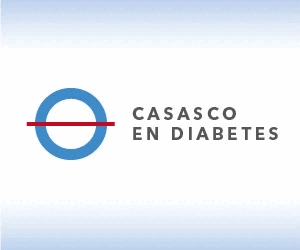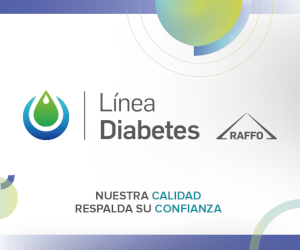Transportadores celulares de drogas. El viaje de los antidiabéticos orales por el organismo
DOI:
https://doi.org/10.47196/diab.v51i4.40Palabras clave:
transporte celular de drogas, farmacocinética, antidiabéticos oralesResumen
La diabetes mellitus tipo 2 requiere tratamiento farmacológico múltiple para lograr los objetivos establecidos y el control de las comorbilidades. Por lo tanto, dicho tratamiento propende a la interacción medicamentosa. Se entiende por tal a los efectos observados, sean terapéuticos o adversos, resultantes de la administración concomitante de dos o más fármacos a un paciente, concepto que debería extenderse a los alimentos, cosméticos y sustancias ambientales.
Durante años las interacciones entre drogas se estudiaron en forma descriptivo-empírica y recién en las últimas décadas se dio jerarquía a los mecanismos participantes. Las interacciones farmacocinéticas involucran los procesos absortivos, distributivos y de eliminación donde intervienen enzimas y moléculas de transporte, y en la actualidad se aprecia un interés aún mayor por estas últimas como fuente de interacciones.
El objetivo de este trabajo es describir los transportadores intervinientes en la farmacocinética de los antidiabéticos orales y, de esta manera, discernir si potencialmente pudiera existir alguna interferencia al momento de indicar un nuevo fármaco agregado.
Citas
Inzucchi SE, Bergenstal RM, Buse JB, et al. Management of hyperglycemia in type 2 diabetes, 2015. A patient-centered approach: update to a position statement of the American Diabetes Association and the European Association for the Study of Diabetes. Diabetes Care 2015;3 8: 140-9.
Tahrani AA, Bailey CJ, Del Prato S, et al. Management of type 2 diabetes: new and future developments in treatment. Lancet 2011; 378(9786): 182-97.
Ponte ML, Wachs L, Wachs A, Serra HA. Prescribing cascade. A proposed new way to evaluate it. Medicina (B Aires) 2017; 77: 13-16.
Gravelle S, Joly L, Detcheverry F, Ybert C, Cottin-Bizonne C, Bocquet L. Optimizing water permeability through the hourglass shape of aquaporins. PNAS 2013; 110: 16367-72.
Alexander SPH, Kelly E, Marrion N, Peters JA, Benson HE, Faccenda E, et al. The Concise Guide to PHARMACOLOGY 2015/16: Overview. Br J Pharmacol 2015; 172: 5729-43.
Alexander SPH, Kelly E, Marrion N, Peters JA, Benson HE, Faccenda E, et al. The Concise Guide to PHARMACOLOGY 2015/16: Transporters. Br J Pharmacol 2015; 172: 6110-202.
Schumacher T, Benndorf RA. ABC transport proteins in cardiovascular disease-a brief summary. Molecules 2017; 22 pii: E589.
Giacomini KM, Sugiyama Y. Transportadores de membrana y respuesta a los fármacos. En: Brunton L, Chabner B, Knollman B, Eds. Goodman & Gilman. Las bases farmacológicas de la terapéutica. 12 Ed. México: Mc Graw-Hill Interamericana 2012; 89-121.
González F, Coughtrie M, Tukey RH. Metabolismo de los fármacos. En: Brunton L, Chabner B, Knollman B, Eds. Goodman & Gilman. Las bases farmacológicas de la terapéutica. 12 Ed. México: Mc Graw-Hill Interamericana 2012; 123-43.
Nigam SK. What do drug transporters really do? Nat Rev Drug Dis 2015; 14: 29-44.
He L, Vasiliou K, Nerbert DW. Analysis and update of the human solute carrier (SLC) gene superfamily. Hum Genomics 2009; 2: 195-206.
Schlessinger A, Khuri N, Giacomini KM, Sali A. Molecular modeling and ligand docking for solute carrier (SLC) transporters. Curr Top Med Chem 2013; 13: 843-56.
Colasa C, Unga PM, Schlessinger A. SLC transporters: structure, function, and drug discovery. Med Chem Comm 2016; 7: 1069-81.
Reyes N, Ginter C, Boudker O. Transport mechanism of a bacterial homologue of glutamate transporters. Nature 2009; 462: 880-5.
Palacín M, Nunes V, Font-Llitjós M, et al. The genetics of heteromeric amino acid
transporters. Physiology 2005; 20: 112-24.
Fotiadis D, Kanai Y, Palacín M. The SLC3 and SLC7 families of amino acid transporters. Mol Aspects Med 2013; 34: 139-58.
Wilkens S. Structure and mechanism of ABC transporters. F1000Prime Reports 2015; 7: 14. doi:10.12703/P7-14. eCollection 2015.
Gomperts BD, Tatham PER, Kramer IM. Signal Transduction. London: Elsevier Academic Press. 2002.
Palma AG, Kotsias BA, Marino GI. Funciones de los canales iónicos CFTR y ENAC en la fibrosis quística. Medicina (Bs As) 2014; 74: 133-9.
Vasiliou V, Vasiliou K, Nebert DW. Human ATP-binding cassette (ABC) transporter family. Hum Genomics 2009; 3: 281-90.
Iannantuono RF, Serra HA, Zieher LM. Farmacocinética I: absorción, distribución y eliminación de fármacos. En: Zieher LM y col, Eds. Farmacología General y de la Neurotransmisión, 3º Ed. Buenos Aires: Librería Ursino 2003; 1-24.
Guías para el tratamiento de la diabetes mellitus tipo 2. Sociedad Argentina de Diabetes AC; 2016.
Graham GG, Punt J, Arora M, Day RO, Doogue MP, Duong JK, et al. Clinical pharmacokinetics of metformin. Clin Pharmacokinet 2011; 50: 81-98.
Stepensky D, Friedman M, Raz I, Hoffman A. Pharmacokinetic-pharmacodynamic analysis of the glucose-lowering effect of metformin in diabetic rats reveals first-pass pharmacodynamic effect. Drug Metab Dispos 2002; 30: 861-8.
Gong L, Goswami S, Giacomini KM, Altman RB, Kleina TE. Metformin pathways: pharmacokinetics and pharmacodynamics. Pharmacogenet Genomics 2012; 22: 820-7.
Song NN, Li QS, Liu CX. Intestinal permeability of metformin using single-pass intestinal perfusion in rats. World J Gastroenterol 2006; 12: 4064-70.
Shu Y, Brown C, Castro RA, Shi RJ, Lin ET, Owen RP, et al. Effect of genetic variation in the Organic Cation Transporter 1, OCT1, on metformin pharmacokinetics. Clin Pharmacol Ther 2008; 83: 273-80.
Serra HA, Rizzo LF. Point to note on the metformin absorption. 4th International Congress on Prediabetes and the Metabolic Syndrome. Madrid; 2011.
Scarpello JH, Howlett HC. Metformin therapy and clinical uses. Diab Vasc Dis Res 2008; 5:157-167.
Bailey CJ, Wilcock C, Scarpello JH. Metformin and the intestine. Diabetologia 2008; 51:1552-1553.
Parra D, Legreid AM, Beckey NP, Reyes S. Metformin monitoring and change in serum creatinine levels in patients undergoing radiologic procedures involving administration of intravenous contrast media. Pharmacotherapy 2004; 24: 987-93.
Nies AT, Koepsell H, Damme K, et al. Organic cation transporters (OCTs, MATEs) in vitro and in vivo evidence for the importance in drug therapy. Handb Exp Pharmacol 2011; 105-167.
Glucophage (metformin hydrochloride) US prescribing information. Bristol-Myers Squibb Company April 5, 2017.
Radwan MA, Al Taweel ES, Al-Moghairi AM, Aloudah NM, Al Babtain MA, Al-Amri HS. Monitoring metformin in cardiac patients exposed to contrast media using ultra-high-performance liquid chromatography tandem mass-spectrometry. Ther Drug Monit 2011; 33: 742-9.
Sola D, Rossi L, Carnevale Schianca GP, Maffioli P, Bigliocca M, Mella R, et al. Sulfonylureas and their use in clinical practice. Arch Med Sci 2015; 12: 840-8.
Li X, Liu ZQ. Pharmacogenetic factors that affect drug metabolism and efficacy in type 2 diabetes mellitus. In: Xie W, ed. Drug metabolism in diseases. Amsterdam: Elsevier Academic Press 2017; 157-79.
Klatt S, Fromm MF, König J. Transporter-mediated drug-drug interactions with oral antidiabetic drugs. Pharmaceutics 2011; 3: 680-705.
Gedeon C, Behravan J, Koren G, Piquette-Miller M. Transport of glyburide by placental ABC transporters: implications in fetal drug exposure. Placenta 2006; 27: 1096-102.
Golstein PE, Boom A, van Geffel J, Jacobs P, Masereel B, Beauwens R. P-glycoprotein inhibition by glibenclamide and related compounds. Pflugers Arch 1999; 437: 652-60.
Pollex E, Lubetsky A, Koren, G. The role of placental breast cancer resistance protein in the efflux of glyburide across the human placenta. Placenta 2008; 29: 743-7.
Satoh H, Yamashita F, Tsujimoto M, Murakami H, Koyabu N, Ohtani H, et al. Citrus juices inhibit the function of human organic anion-transporting polypeptide OATP-B. Drug Metab Dispos 2005; 33: 518-23.
Guardado-Mendoza R, Prioletta A, Jiménez-Ceja LM, Sosale A, Folli F. The role of nateglinide and repaglinide, derivatives of meglitinide, in the treatment of type 2 diabetes mellitus. Arch Med Sci 2013; 9: 936-43.
Scheen AJ. Pharmacokinetic interactions with thiazolidinediones. Clin Pharmacokinet 2007; 46: 1-12.
Kirchheiner J, Thomas S, Bauer S, Tomalik-Scharte D, Hering U, Doroshyenko O, et al. Pharmacokinetics and pharmacodynamics of rosiglitazone in relation to CYP2C8 genotype. Clin Pharmacol Ther 2006; 80: 657-67.
Hemauer SJ, Patrikeeva SL, Nanovskaya TN, Hankins GDV, Ahmed MS. Role of human placental apical membrane transporters in the efflux of glyburide, rosiglitazone and metformin. Am J Obstet Gynecol 2010; 202: 383.e1-e7.
Scheen AJ. Pharmacokinetics of dipeptidylpeptidase-4 inhibitors. Diabetes Obes Metab 2010; 12: 648-58.
Maladkar M, Sankar S, Kamat K. Teneligliptin: heralding change in type 2 diabetes. J Diabetes Mellitus 2016; 6: 113-131.
Scheen AJ. Dipeptidylpeptidase-4 inhibitors (Gliptins). Focus on drug-drug interactions. Clin Pharmacokinet 2010; 49: 573-88.
Chu XY, Bleasby K, Yabut J, Cai X, Chan GH, Hafey MJ, et al. Transport of the dipeptidyl peptidase-4 inhibitor sitagliptin by human organic anion transporter 3, organic anion transporting polypeptide 4C1, and multidrug resistance P-glycoprotein. J Pharmacol Exp Ther 2007; 321: 673-83.
Kalra S. Sodium glucose co-transporter-2 (SGLT-2) inhibitors: a review of their basic and clinical pharmacology. Diabetes Ther 2014; 5: 355-66.
Lamos EM, Younk LM, Davis SN. Canagliflozin, an inhibitor of sodium-glucose cotransporter 2, for the treatment of type 2 diabetes mellitus. Expert Opin Drug Metab Toxicol 2013; 9: 763-75.
Scheen AJ. Pharmacokinetic and pharmacodynamic profile of empagliflozin, a sodium glucose co-transporter 2 inhibitor. Clin Pharmacokinet 2014; 23: 213-25.
Kasichayanula S, Liu X, Lacreta F, Griffen SC, Boulton DW. Clinical pharmacokinetics and pharmacodynamics of dapagliflozin, a selective inhibitor of sodium-glucose co-transporter type 2. Clin Pharmacokinet 2014; 53: 17-27.
Devineni D, Curtin CR, Polidori D, Gutierrez MJ, Murphy J, Rusch S, et al. Pharmacokinetics and pharmacodynamics of canagliflozin, a sodium glucose co-transporter 2 inhibitor, in subjects with type 2 diabetes mellitus. J Clin Pharmacol 2013; 53: 601-10.
Obermeier M, Yao M, Khanna A, et al. In vitro characterization and pharmacokinetics of dapagliflozin (BMS-512148), a potent sodium-glucose cotransporter type II inhibitor, in animals and humans. Drug Metab Dispos 2010; 38:
-14.
Plosker GL. Canagliflozin: a review of its use in patients with type 2 diabetes mellitus. Drugs 2014; 74: 807-24.
Umehara KI, Iwatsubo T, Noguchi K, Usui T, Kamimura H. Effect of cationic drugs on the transporting activity of human and rat OCT/Oct 1-3 in vitro and implications for drug-drug interactions. Xenobiotica 2008; 38: 1203-18.
Bachmakov I, Glaeser H, Endress B, Mörl F, König J, Fromm MF. Interaction of beta-blockers with the renal uptake transporter OCT2. Diabetes Obes Metab 2009; 11: 1080-3.
Zolk O, Solbach TF, König J, Fromm MF. Structural determinants of inhibitor interaction with the human Organic Cation Transporter OCT2 (SLC22A2). Naunyn-Schmied Arch Pharmacol 2008; 379: 337-48.
Müller F, König J, Glaeser H, Schmidt I, Zolk O, Fromm MF, et al. Molecular mechanism of renal tubular secretion of the antimalarial drug chloroquine. Antimicrob Agents Chemother 2011; 55: 3091-8.
Meyer zu Schwabedissen HE, Verstuyft C, Kroemer HK, Becquemont L, Kim RB. Human Multidrug and Toxin Extrusion 1 (MATE1/SLC47A1) transporter: Functional characterization, interaction with OCT2 (SLC22A2), and single nucleotide polymorphisms. Am J Physiol Renal Physiol 2010; 298: F997-F1005.
Umehara KI, Iwatsubo T, Noguchi K, Kamimura H. Comparison of the kinetic characteristics of inhibitory effects exerted by biguanides and H2-blockers on human and rat organic cation transporter-mediated transport: insight into the development of drug candidates. Xenobiotica 2007; 37: 618-34.
Wang ZJ,Yin OQ, Tomlinson B, Chow MS. OCT2 polymorphisms and in-vivo renal functional consequence: Studies with metformin and cimetidine. Pharmacogenet Genomics 2008; 18: 637-45.
May M, Schindler C. Clinically and pharmacologically relevant interactions of antidiabetic drugs. Ther Adv Endocrinol Metab 2016; 7: 69-83.
Minematsu T, Giacomini KM. Interactions of tyrosine kinase inhibitors with organic cation transporters and multidrug and toxic compound extrusion proteins. Mol Cancer Ther 2011; 10: 531-9.
Zheng, HX, Huang Y, Frassetto LA, Benet LZ. Elucidating rifampin's inducing and inhibiting effects on glyburide pharmacokinetics and blood glucose in healthy volunteers: Unmasking the differential effects of enzyme induction and transporter inhibition for a drug and its primary metabolite. Clin Pharmacol Ther 2008; 85: 78-85.
Fuchikami H. Effects of herbal extracts on the function of human organic anion-transporting polypeptide OATP-B. Drug Metab. Dispos 2006; 34: 577-82.
Lilja JJ, Niemi M, Fredrikson H. Effects of clarithromycin and grapefruit juice on the
pharmacokinetics of glibenclamide. Br J Clin Pharmacol 2007; 63: 732-40.
Grube M, Köck, K, Oswald S, Draber K, Meissner, K, Eckel L, et al. Organic Anion Transporting Polypeptide 2B1 is a high-affinity transporter for atorvastatin and is expressed in the human heart. Clin Pharmacol Ther 2006; 80: 607-20.
Hirano M, Maeda K, Shitara Y, Sugiyama Y. Drug -drug interaction between pitavastatin and various drugs via OATP1B1. Drug Metab Dispos 2006; 34: 1229-36.
Gong IY, Kim RB. Impact of genetic variation in OATP transporters to drug disposition and response. Drug Metab Pharmacokinet 2013; 28: 4-18.
Gedeon C, Behravan, J, Koren G, Piquette-Miller M. Transport of glyburide by placental ABC transporters: Implications in fetal drug exposure. Placenta 2006; 27: 1096-102.
Mita S. Inhibition of bile acid transport across Na+/taurocholate cotransporting polypeptide (SLC10A1) and bile salt export pump (ABCB11)-coexpressing LLC-PK1 cells by cholestasis-inducing drugs. Drug Metab Dispos 2006; 34: 1575-81.
Kis E, Ioja E, Nagy T, Szente L, Heredi-Szabo K, Krajcsi P. Effect of membrane cholesterol on BSEP/Bsep activity: Species specificity studies for substrates and inhibitors. Drug Metab Dispos 2009; 37: 1878-86.
Kalliokoski A, Backman JT. Effects of gemfibrozil and atorvastatin on the pharmacokinetics of repaglinide in relation to SLCO1B1 polymorphism. Clin Pharmacol Ther 2008; 84: 488-96.
Niemi M. The cytochrome P4503A4 inhibitor clarithromycin increases the plasma concentrations and effects of repaglinide. Clin Pharmacol Ther 2001; 70: 58-65.
Nozawa T, Sugiura S, Nakajima M, Goto A, Yokoi T, Nezu J, et al. Involvement of organic anion transporting polypeptides in the transport of troglitazone sulfate: Implications for understanding troglitazone hepatotoxicity. Drug Metab Dispos 2004; 32: 291-4.
Gui C, Miao Y, Thompson L, Wahlgren B, Mock M, Stieger B, et al. Effect of pregnane X receptor ligands on transport mediated by human OATP1B1 and OATP1B3. Eur J Pharmacol 2008; 584: 57-65.
Bachmakov I, Glaeser H, Fromm MF, König J. Interaction of oral antidiabetic drugs with hepatic uptake transporters: Focus on organic anion transporting polypeptides and organic cation transporter 1. Diabetes 2008; 57: 1463-9.
Choi MK, Jin QR. Sitagliptin attenuates metformin-mediated AMPK phosphorylation through Inhibition of organic cation transporters. Xenobiotica 2010; 40: 817-25.
He YL, Ligueros-Saylan M, Sunkara G, Sabo R, Zhao C, Wang Y, et al. Vildagliptin, a novel dipeptidyl peptidase IV inhibitor, has no pharmacokinetic interactions with the antihypertensive agents amlodipine, valsartan, and ramipril in healthy subjects. J Clin Pharmacol 2008; 48: 85-95.
Descargas
Publicado
Cómo citar
Número
Sección
Licencia

Esta obra está bajo una licencia internacional Creative Commons Atribución-NoComercial-SinDerivadas 4.0.
Dirección Nacional de Derecho de Autor, Exp. N° 5.333.129. Instituto Nacional de la Propiedad Industrial, Marca «Revista de la Sociedad Argentina de Diabetes - Asociación Civil» N° de concesión 2.605.405 y N° de disposición 1.404/13.
La Revista de la SAD está licenciada bajo Licencia Creative Commons Atribución – No Comercial – Sin Obra Derivada 4.0 Internacional.
Por otra parte, la Revista SAD permite que los autores mantengan los derechos de autor sin restricciones.



























